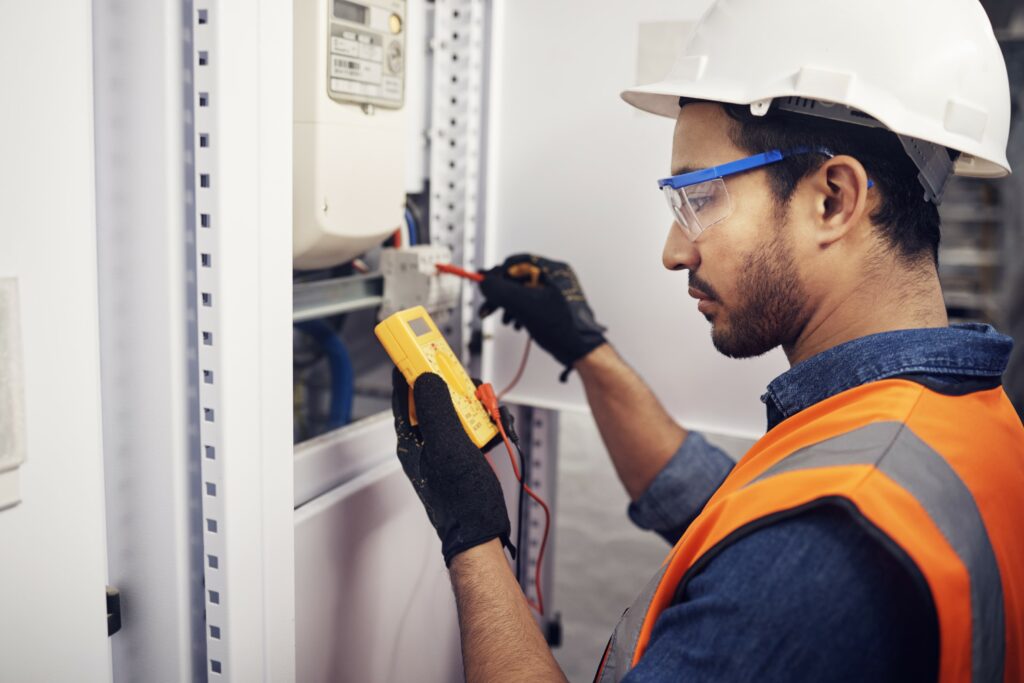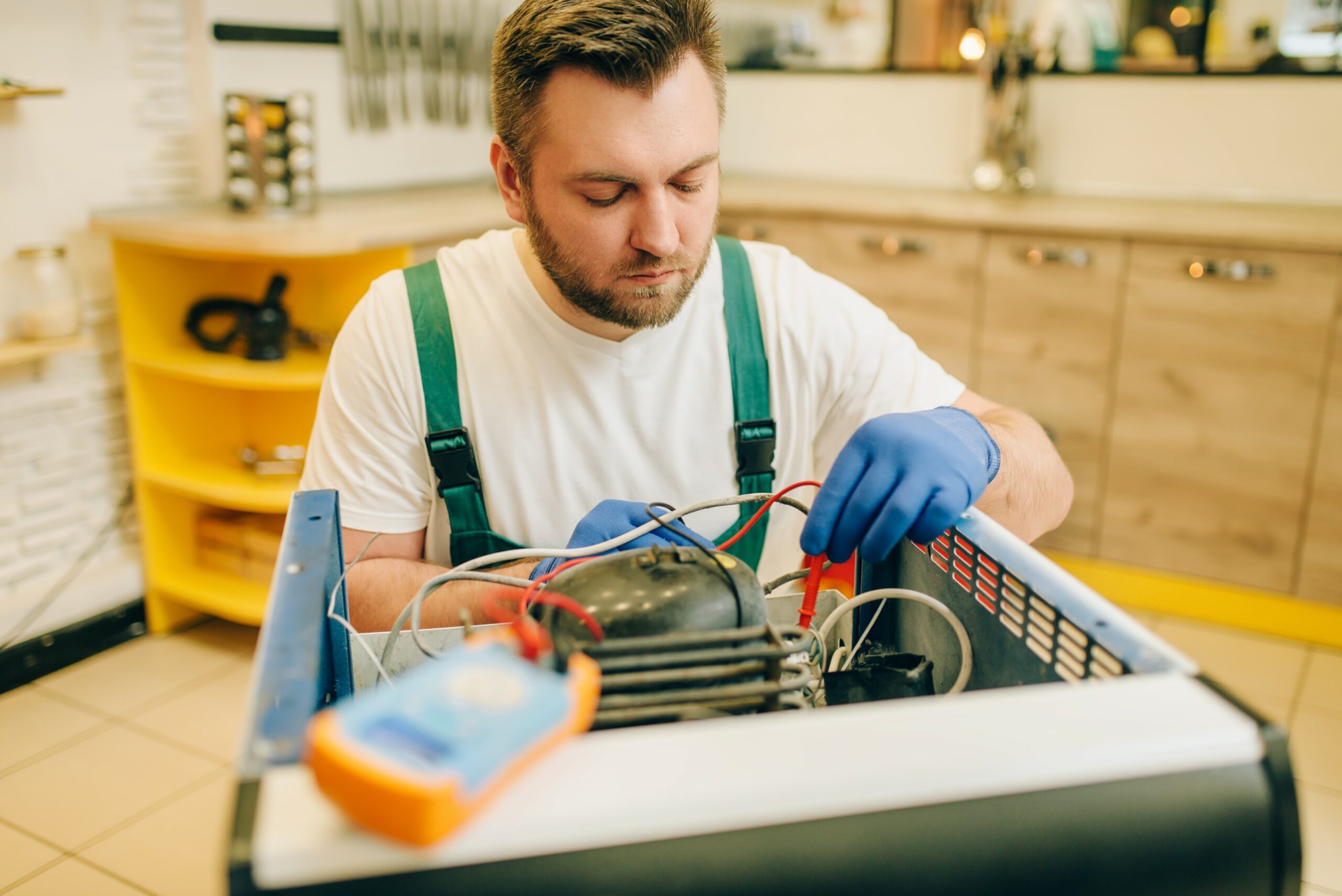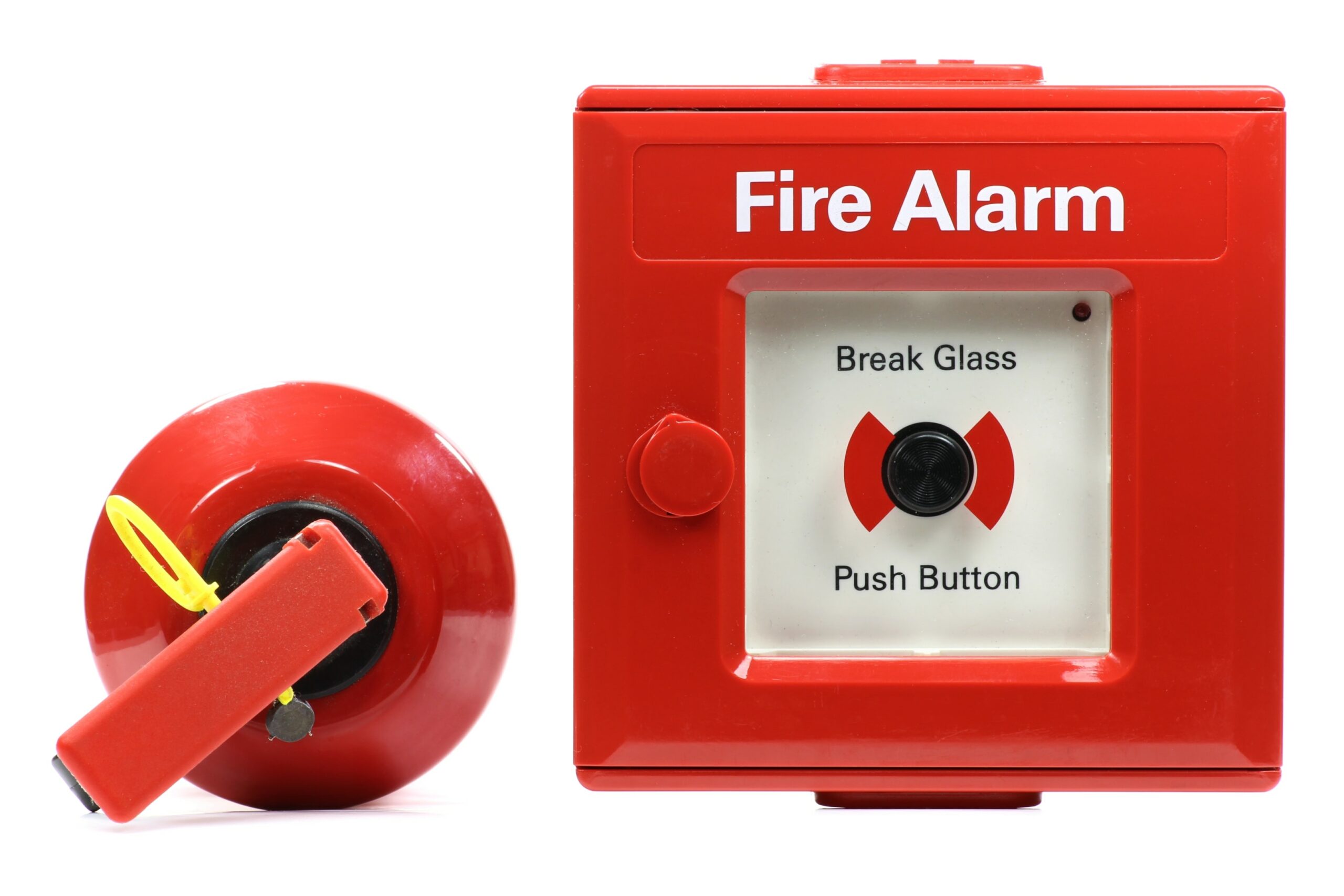Why Portable Appliance Testing (PAT) is Essential for Workplace Safety and Compliance
Portable Appliance Testing (PAT) ensures electrical appliances are safe. It involves inspecting and testing appliances to find and fix potential hazards. This article explains what PAT testing is and why it matters for workplace safety and compliance.
Table of Contents
Key Takeaways
- Regular Portable Appliance Testing (PAT) is essential for minimising electrical hazards and ensuring compliance with safety regulations in the workplace.
- Employers are legally responsible for maintaining electrical equipment in a safe condition, and adopting a risk-based approach to PAT testing is crucial for effective safety management.
- Competent personnel must conduct PAT tests to identify potential electrical risks, and accurate documentation of test results is vital for compliance and future audits.
Understanding Portable Appliance Testing (PAT)

Portable Appliance Testing (PAT) includes a comprehensive inspection of portable electrical appliances. This process ensures that the appliances are safe for usage. This process is crucial for minimising electrical hazards, such as shocks and fires, by identifying potential issues in appliances ranging from kitchen gadgets to power tools.
While the law mandates that electrical equipment must be maintained for safety, it does not specify the methods or frequency of testing. This flexibility allows for a risk-based approach to PAT testing, tailored to the specific needs of each workplace.
What is Portable Appliance Testing?
Portable Appliance Testing (PAT) refers to the systematic examination of electrical appliances to ensure they are safe for use. The primary goal of PAT testing is to minimise electrical hazards by ensuring that appliances, such as computers and kitchen gadgets, are safe to operate. This process involves various tests and inspections, conducted using specialised PAT testing equipment, to identify any faults that could pose a risk to users.
Regular PAT tests help businesses maintain the safety and reliability of their electrical appliances.
Importance of PAT Testing
Regular PAT testing is crucial for identifying potential electrical hazards, thereby preventing accidents and ensuring compliance with safety regulations. It is a proactive approach to managing electrical risks, ensuring that appliances are safe for use and reducing the likelihood of electrical injuries.
The legal framework mandates that electrical appliances must be kept in a condition that does not pose a risk of injury. Therefore, it is essential for individuals performing PAT tests to possess the necessary competence and training to ensure safety and understand their legal requirements and legal responsibilities.
Legal Requirements for Portable Appliance Testing
Employers are mandated to ensure that electrical equipment is kept in a safe condition to prevent hazards. This responsibility is reinforced by safety regulations and the safety policy, which require employers to assess and manage risks related to electrical equipment in the workplace.
The legal obligations regarding Portable Appliance Testing (PAT) are crucial for ensuring electrical safety in the workplace. Meeting these legal requirements ensures compliance and promotes a safe working environment.
Work Regulations and Legal Duties
The Electricity at Work Regulations 1989 state that:
- Electrical equipment must be maintained.
- This maintenance is necessary to prevent any potential danger.
- Employers must ensure that electrical equipment is maintained safely to prevent health and safety risks that any electrical equipment may pose.
The Health and Safety Executive (HSE) provides guidance on how to maintain equipment, including the use of Portable Appliance Testing (PAT). While regulations don’t specify testing frequency or methods, adopting a risk-based approach ensures safety and compliance.
Responsibilities of Employers and Landlords
Key points about PAT testing responsibilities and benefits:
- Landlords must ensure that any electrical appliances provided in rented property are safe for use.
- Employers have the responsibility to conduct regular PAT tests to identify electrical risks before they lead to accidents.
- Regular PAT testing improves safety by identifying hazards before they cause accidents.
While there is no legal obligation for employers to label inspected or tested equipment, it can be beneficial for management and compliance.
Conducting Portable Appliance Tests

Conducting Portable Appliance Tests involves several steps, starting with visual inspections to identify any obvious damage or defects in the appliance. Electrical tests like earth continuity, insulation resistance, and leakage testing are vital for appliance safety and compliance, using annual portable appliance testing equipment and portable appliance testing.
Accurate documentation of test results is crucial for compliance and future reference. This section will delve into each of these steps in detail, providing a comprehensive guide to conducting PAT tests and preparing for the next test.
Visual Inspections
Visual inspections are a critical part of maintaining electrical safety, as they help identify any obvious damage or defects in appliances. Employers should regularly inspect equipment, emphasising formal visual inspection as a key maintenance step.
New appliances should undergo an initial visual inspection to confirm they are free from damage before use. New appliance-tested equipment generally doesn’t require formal testing, but should undergo quick visual inspections to check for damage.
Electrical Tests
Electrical tests are critical for ensuring the safety and functionality of portable appliances during PAT testing. These tests include the earth test, which verifies that the earth connection of an appliance is sound, preventing electrical shocks. The earth continuity test is an essential part of this process. Electrical testing is an essential part of this process.
Insulation resistance testing checks the integrity of an appliance’s insulation to prevent current leakage, protecting users from electrical hazards. Leakage testing assesses the amount of current that may escape from an appliance, further reducing the risk of electrical shock.
Recording Test Results
Test results should include details such as the test date, the person conducting the test, and any defects found. Documenting test results is essential for ensuring compliance with safety regulations and for keeping a record of the appliance’s testing history.
Well-maintained test records are invaluable for future inspections and audits, proving compliance and diligence in previous tests of electrical safety.
Frequency of Portable Appliance Testing
Employers are required to adopt a risk-based strategy for maintaining electrical equipment and portable equipment, depending on their usage and environment, in accordance with the IEE code. The frequency of testing for portable appliances is influenced by their type and the environment in which they are used.
A thorough approach that considers risk and environmental factors should determine PAT testing frequency. This section will explore the different factors that influence the frequency of PAT testing.
High-Risk vs Low-Risk Environments
Equipment in high-risk settings, like construction sites, requires more frequent inspections than appliances in low-risk areas, such as offices. Power tools on construction sites need more frequent testing due to higher risk factors.
In low-risk environments, trained personnel can perform visual checks, but comprehensive testing demands more expertise. High-risk environments necessitate more stringent testing protocols to mitigate potential hazards, whereas low-risk environments allow for more flexibility in testing frequency. A thorough risk assessment is essential to ensure safety standards are met.
New vs Existing Equipment
Recommendations for equipment and electrical fault checks:
- Perform a simple visual check on new equipment before use to verify that it has no damage.
- Use PAT testing to identify minor electrical faults early.
- Detect electrical problems early with PAT testing to significantly reduce long-term costs by preventing major repairs or replacements.
Accordingly, new equipment generally does not require formal testing, whereas existing equipment should be regularly tested to ensure ongoing safety through annual testing.
Competence and Training for PAT Testing
Competent individuals performing PAT tests are crucial for ensuring electrical safety and compliance. Only trained staff or professional electricians should perform PAT tests to ensure accuracy and safety. Those conducting PAT tests should complete specific training programs to understand testing procedures and safety requirements.
This section will discuss who can perform PAT testing and the necessary training requirements.
Who Can Perform PAT Testing?
Individuals performing PAT testing should have adequate training and understanding to ensure safety. Knowledgeable and trained staff, as competent and responsible persons, can perform visual inspections for PAT testers in low-risk environments, including persons testing in these settings.
In high-risk environments, it is recommended that only a qualified electrician conduct PAT tests to ensure thoroughness and compliance with safety standards.
Training Requirements
Competent individuals conducting PAT tests are vital for maintaining electrical safety and compliance. PAT testing course content is certified and conforms to CPD guidelines. Comprehending testing procedures and safety requirements is crucial for those performing PAT tests to accurately identify and address electrical hazards.
Why Choose TF Installations Ltd for PAT Testing
Choosing the right company for your Portable Appliance Testing (PAT) needs is crucial for ensuring the safety and compliance of your electrical equipment. TF Installations Ltd offers expert PAT testing services tailored to meet the specific requirements of your workplace or property. Our team of trained and competent professionals uses the latest PAT testing equipment and follows industry best practices to deliver thorough and reliable inspections.
We understand the importance of maintaining portable electric equipment in safe working order and provide detailed reports that include all necessary test results, ensuring transparency and peace of mind. Our approach includes combined inspection and testing, covering visual inspections, earth continuity tests, insulation tests, and leakage testing, to comprehensively assess the condition of your portable appliances.
TF Installations Ltd also recognises the varying needs of different equipment and appliance types, offering flexible testing schedules based on risk assessments and usage patterns. Whether your appliances are class I or class II, our technicians are equipped to handle the specific requirements of each appliance type, including those with exposed metal parts or thermal damage concerns.
We prioritise clear communication and provide comprehensive PAT test certificates that document all tests carried out, including electrical readings and recommendations for re-testing when necessary. Our commitment to quality and compliance makes us a trusted partner for businesses seeking to meet their legal obligations and maintain a safe environment for staff and visitors.
By choosing TF Installations Ltd, you benefit from our extensive experience in portable appliance maintenance, adherence to safety regulations, and a customer-focused approach that ensures your equipment is tested efficiently and effectively. Let us help you manage your portable electrical appliances with confidence, knowing that your safety and compliance needs are in expert hands.
Maintaining Records and Certificates
Keeping accurate records of test results helps demonstrate compliance with safety regulations and supports future maintenance. Documenting test results is essential for compliance with safety regulations and for tracking the maintenance history of each appliance. Proper documentation and reporting are essential for overcoming PAT testing challenges, maintaining transparency and compliance.
This section will explore what records should include and the importance of PAT test certificates.
What Should Records Include?
Records should document test dates, appliance details, and the outcomes of inspections for effective tracking. Documenting maintenance activities for electrical equipment is recommended as a best practice, even if not legally required.
Keeping accurate records of PAT testing is crucial for compliance with safety regulations and for tracking the safety of electrical appliances. Thorough record-keeping boosts compliance and enhances overall electrical safety in the workplace.
Understanding PAT Test Certificates
A PAT test certificate officially confirms the completion of testing and the safety of appliances. Companies can use PAT certificates to ensure compliance with health and safety regulations. A complete PAT test report may include:
- The description of the appliance
- Location
- Tests conducted
- Electrical readings
A PAT test certificate should include the total number of items tested and their safety status. These certificates are crucial for providing evidence of appliance safety, which is important in legal disputes.
Common Challenges in PAT Testing and How to Overcome Them
Common challenges in PAT testing often arise from equipment defects and test procedures. Frequent issues include:
- Damaged cables and faulty plugs are major contributors to equipment failures.
- Incorrect sequence of tests, leading to unreliable results.
- Equipment is not being adequately powered down before testing, which can cause accidents.
This section will discuss strategies to overcome these challenges.
Dealing with Inaccessible Equipment
When PAT testing hard-to-reach appliances, safety should be the top priority. Using appropriate ladders or tools and extension leads can help prevent accidents and facilitate access to hard-to-reach appliances for effective PAT testing.
Flexible testing tools are invaluable for accessing hard-to-reach appliances during PAT testing. These strategies ensure that even the most challenging test equipment and test instruments can be tested safely and efficiently to achieve repeatable results.
Managing Large Inventories
Regular portable appliance testing helps ensure safety compliance and prevents electrical hazards, thereby protecting staff and property. Accurate records and certificates of PAT tests are crucial for effective management and future reference. Competence and training for PAT testing personnel ensure accurate and consistent testing.
Different types of portable appliances require varying frequencies of testing based on their usage and the environment they are in. A systematic inventory maintenance system can streamline the testing schedule and record-keeping for multiple portable appliance maintenance tasks.
Benefits of Regular Portable Appliance Testing
PAT testing:
- Identifies safety concerns that may not be visible during standard visual inspections.
- Includes electrical tests like earth continuity and insulation resistance to identify hidden faults in appliances.
- Provides records that help monitor and assess the effectiveness of maintenance plans.
This section will detail the benefits of regular PAT testing, including enhanced safety, compliance and liability protection, and cost savings.
Enhanced Safety
Frequent PAT testing offers several safety benefits:
- Significantly reduces the likelihood of workplace electrical injuries.
- Reduces the risk of electric shock and fire hazards, ensuring a safer environment.
- Identifies faults before they become serious hazards, creating a safer environment.
Regular visual inspections and maintenance of electrical equipment improve safety in the work environment.
Compliance and Liability Protection
Portable appliance testing (PAT) is governed by various legal requirements, including the Electricity at Work Regulations 1989, which mandate that employers ensure electrical safety in the workplace. Complying with PAT testing regulations helps businesses avoid penalties and improve occupational safety.
Employers and landlords have specific responsibilities to ensure that all portable appliances are regularly tested and maintained to meet legal standards. Proper documentation of PAT testing results reduces liability risk by proving compliance and due diligence in electrical safety.
Cost Savings
Addressing electrical issues promptly through regular testing can result in significant long-term financial savings. Early identification and resolution of electrical issues can save long-term costs. Regular PAT testing prevents major repairs or replacements by catching minor faults early.
This proactive approach not only saves money but also minimises downtime, ensuring that equipment remains operational and operating correctly.
Summary
Portable Appliance Testing (PAT) is an essential practice for ensuring electrical safety and compliance in the workplace. From understanding what PAT testing involves to recognising its importance, legal requirements, and the detailed process of conducting tests, this guide has covered all the critical aspects. Regular PAT testing not only enhances safety and compliance but also offers significant cost savings in the long run. By maintaining accurate records and ensuring that competent individuals conduct the tests, businesses can protect their employees and assets. Embracing PAT testing as a regular part of workplace safety protocols is a proactive step towards a safer and more compliant work environment.
Frequently Asked Questions
What is the purpose of Portable Appliance Testing (PAT)?
The purpose of Portable Appliance Testing (PAT) is to minimise electrical hazards by ensuring the safety and proper functioning of electrical appliances. By conducting PAT, organisations can protect users from potential electrical risks.
How often should PAT testing be conducted?
PAT testing should be conducted with increased frequency in high-risk environments compared to low-risk areas, as the specific needs can vary based on the type and usage of the appliances.
Who is qualified to perform PAT testing?
Only individuals with adequate training and understanding are qualified to perform PAT testing, though trained non-electricians may conduct visual inspections in low-risk environments.
What should be included in PAT test records?
PAT test records should include test dates, appliance details, and inspection outcomes to ensure compliance and monitor the safety of electrical devices.
What are the legal requirements for PAT testing?
It is legally required under the Electricity at Work Regulations 1989 for employers to maintain electrical equipment to prevent danger, ensuring a safe working environment. Compliance with these regulations is crucial to uphold safety standards in the workplace.










